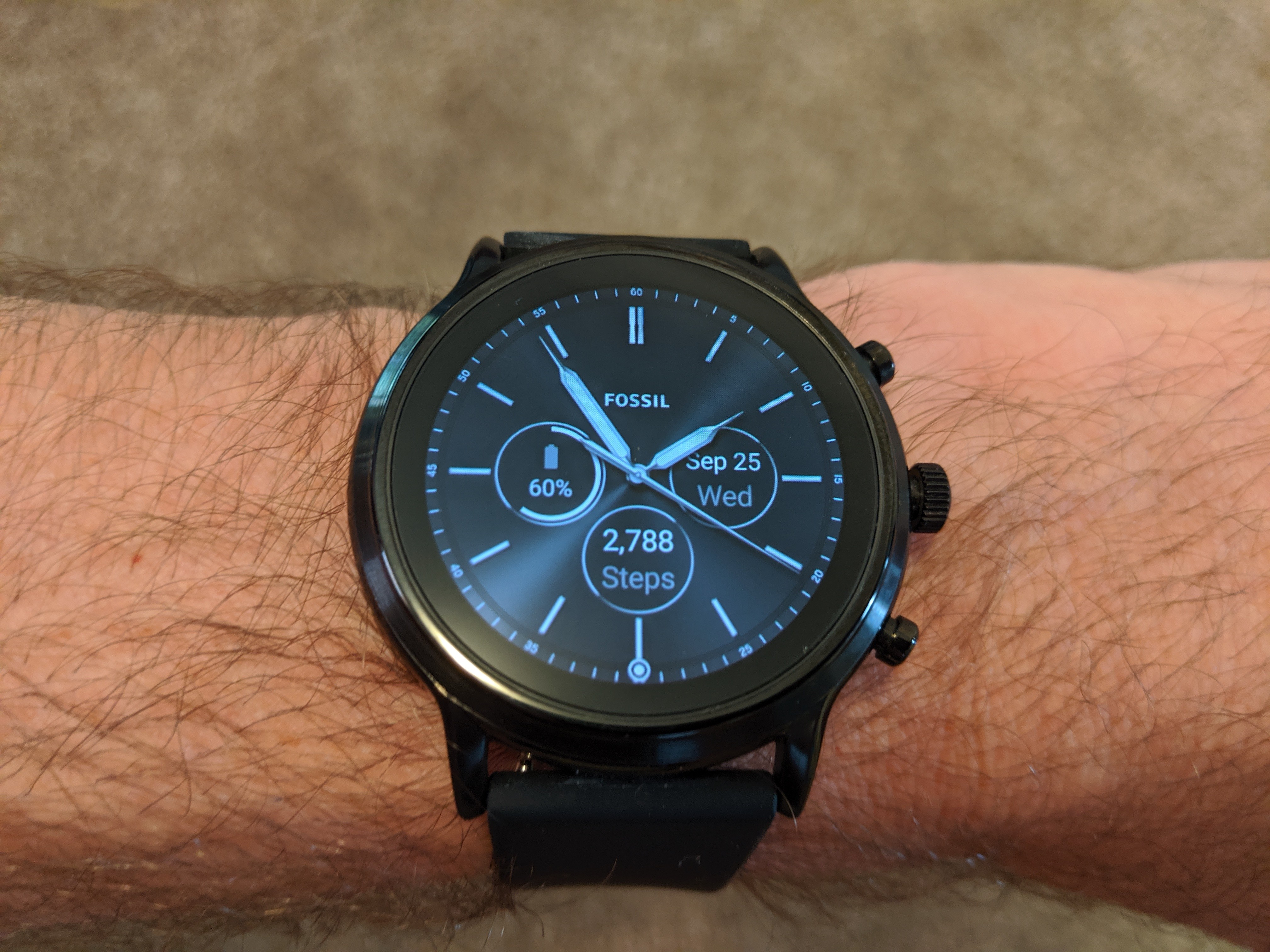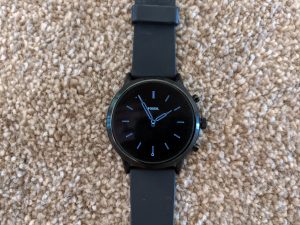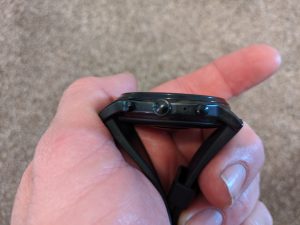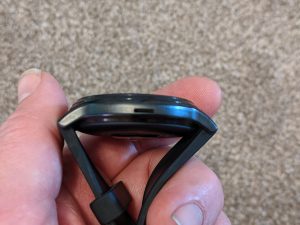Without a doubt Wear OS may well be dead, or at least on life support, if it wasn’t for Fossil. The fashion brand has embraced smartwatches as an essential segment of their product line up and is responsible for the majority of the devices on the market.
Fossil’s commitment hasn’t been a passing fancy with the company now onto the 5th generation of their smartwatch platform. One of the things we love about Fossil is they make a core technology platform each generation and then release multiple devices from their brands, this provides the kind of options needed to provide a wide range of consumer choice.
We’ve had our hands, or is that wrist, on with the Fossil Carlyle HR is black silicon for a few weeks now, and it’s definitely an improvement over any Wear OS watch we’ve tried before. How good? Read on to find out.
WHAT’S INSIDE?
As previously mentioned we love Fossils approach to smartwatches, develop a standard digital platform and encase that in various designs, finishes and colours. The heart of the new platform is the Generation 5 digital movement.
Inside there is a Snapdragon Wear 3100 SOC paired with 1GB of RAM, 8 GB of storage, Bluetooth, WiFi, inbuilt GPS and NFC for Google Pay. On the outside, there’s a 1.3-inch OLED display, 3 buttons with the middle button including a digital crown, speaker, microphone and 22mm interchangeable bands.
The Gen 5 platform does not include LTE at this stage, and to be honest we’re not convinced of the utility of cellular connectivity on a smartwatch at this stage. However, it is one less option for those people who do want it.
Check out the full specs below:
| Key Specifications: | Fossil Carlyle HR |
|---|---|
| Screen size | 1.28-inch |
| Screen technology | OLED |
| Resolution | 416 x 416 |
| PPI | 328 |
| Chipset | Snapdragon Wear 3100 |
| Core config | 1.2 GHz |
| RAM | 1GB |
| Storage | 8GB |
| MicroSD | — |
| Battery | 0 mAh |
| Charging method | Magnetic connecting pin charging |
| WIFI standards | 802.11 b/g/n |
| Bluetooth standards | 4.2 |
| Cellular | No |
| NFC | Yes |
| Location | Yes |
| Speaker | Yes |
| Android OS | Wear OS 2.0 |
| Dimensions | 42 x 12mm |
| Weight | 100g |
| Colours | Various |
| Build materials | Metalic |
| Band colours | Various |
| Band materials | Various |
| Band swappable | Yes |
The design of the physical hardware is partly irrelevant, because if you don’t like the styling of the Fossil Carlyle HR then you can just select another Fossil, Michael Kors, Diesel or Emporio Armani depending on your budget and style.
That said I was very taken with both the Stainless Steel and Black variants of the Carlyle HR. The case is thin and elegant and the overall diameter is smaller than many smartwatches which suits my personal style very well.
If you want to see all of the Gen 5 Smartwatches from Fossil and it’s sub-brands check them out here.
WHAT’S IT GOOD AT?
Knowing what a smartwatch is good at really requires understanding a users use case. Unlike mobile phones which are evolving into a jack of all trades and a master of many, smartwatches seem to be relegated to targeted uses, with different devices targeting different uses cases.
This makes sense given the combination of battery capacity, processors and software required to run everything on a watch still eludes us, especially in the Wear OS space where we are left dealing with Qualcomm’s meodore wearable processors. That said the Gen 5 does bundles in a decent range of features, with nothing missing that I want.
For me a Smartwatch is an extension of my phone, as such, I am not looking for a phone replacement I am looking for a device that brings command and control of my phone to my wrist, oh, and something that tells the time. I should mention I’ve always worn a watch, so for me a smartwatch is a substitution not an addition to my daily devices.
With the Wear OS platform evolving over the past few years there are a few elements of a Wear OS device that we would consider essential including the 3 button interface, digital crown, NFC for Google Pay, heart rate sensor, microphone and a speaker, and the Gen 5 has all of these.
Battery life
Right up front lets deal with most peoples number 1 concern when it comes to smartwatches, battery life. Wear OS (and Android Wear before that) has walked the line to deliver what I see as the holy grail of smartwatches, more than 1 full days battery life with an always-on display.
For me, I want to get up at 6 am, go to bed at 10 pm and still have a decent reserve before I drop my watch on the charger (I’ve never slept wearing a watch, I’m not about to start now). Somewhere in the 30 – 40% left over range would make me happy.
Overall I achieved around 19% battery remaining, sometimes more, sometimes less. While I would still categories this as an ‘all day device’ I would prefer a little more headroom for days when I leave a QR code displayed on my watch rapidly flattening the battery andas well as to combat battery degradation over time. It’s a pass, just not a high pass.
To achieve this battery life however, I did not use all of the features of the device. For the first few weeks I was experimenting with the continuous heart rate monitoring features initially having my HR measured every 60 minutes, then 90 minutes then 3 hourly. What I found is that with ongoing HR monitoring I either ran low on battery before I reached 16 hours off the charger or I toggled of another feature to compensate.
And here is where Fossil is leading the way in Wear OS, battery life control. Meet Fossils custom power saving mode. Using the new feature introduced with the Gen 5 you can get granular control over your watch. This has 2 benefits, you can maximise your battery life, but you also get a convenient command and control dashboard for the device features.
These settings are perfect to customise your system the way you want to use it. don’t care about always-on display but want continuous HR motoring, there’s your trade off and the controls, you will, unfortunately, notice that the continuous HR monitoring isn’t an option, that’s because its an app feature not a system setting.
Google Pay
I can not overstate how convenient it is to pay for things with your watch. It’s convenient, very convenient, and it’s kida cool and still delights me. At this stage if your bank doesn’t support Google Pay, or Samsung Pay, or Garmin Pay (you get the idea) then perhaps it’s time to find a new organisation to have you credit or debit card with, check out every Australian financial inquisition that supports the Google Pay platform, perhaps one of them may suit your digital payment needs.
I use Google Pay so much it has taken pole position as the top programmable button on my watch.
Overall Performance
Wear OS has been portrayed as slow and laggy whenever you do anything beyond basic interactions, I’d like to say that’s not true but historically it has been. The laggy performance has been what has prevented me from recommended Wear OS to “normals”. So did the Wear 3100 and 1GB of RAM solve the problem?
It’s certainly improved it. For instance, I use Google Pay as my benchmark for a device’s performance. Opening Google Pay to the default card is typically quick, it’s clearly always at the ready. However, tapping on the UI to switch between cards has on older devices resulted in upto a 45 second wait (at worst) or even timing out and crashing to the watch dial.
On the Gen 5 platform switching cards is not instant, saying that it is, would be incorrect, it is, however, faster and reliable. From ‘cold’ eg I haven’t used Google Pay in a while and I open the watch from ambient display mode, there’s maybe a 5 second delay in bringing up the Google Pay UI for changing cards. That’s a dramatic improvement, and that improvement is evident right across the device.
Here’s the rub, for me who really wants a wearable, and isn’t interested in any of the ‘fitness first’ wearable I’m happy with that improvement and accepting of the delay/ lag. However, it’s still not 100% consumer-ready, perhaps my expectations are too high, but I think wear OS need to get buttery smooth before it can seriously challenge the popular smartwatch consumer market, and to do that Google needs to step up it’s wearable processor game.
WHAT’S IT LESS GOOD AT?
As a Wear OS device the Fossil Gen 5 signifies a definite step forward for the platform. It’s clear now that the assumption that previous hardware did not have sufficient processing power and RAM have all but been proven. It’s also encouraging that the performance has been improved and I can still expect to get a full day of my usage out of the Gen 5.
For some users the lack of LTE is going to be a no deal situation, especially with some carriers now offering to call your watch in tandem with your phone I can see the appeal, in theory. Perhaps if I tried an LTE watch I would be convinced of it’s benefits but right now I’m happy with non-LTE models, but I wish you had the option of getting one in the Gen 5 platform range.
It is a shame that to use continuous HR monitoring that you need to either sacrifice battery life or another feature, but as previously discussed that seems to be the state of play with Wear OS power management right now, apart from doubling the thickness and dropping in a huge battery there’s not much Fossil can do about that with the current components.
I’ve seen some people criticise Wear OS for not having Electrocardiogram functionality, I am a clinician by training and I have to admit I’m not a fan of non-diagnostic physiological hardware. On one hand, there is an argument that such a device could provide you with an early warning sign of a potential event, and that’s hard to dismiss.
However, on the other hand, there are countless people over-interpreting their ‘personal health data” and seriously causing themselves increased anxiety as a result. If the quality of the clinical tools offered by the current wearables were better I’d likely have less objection, and in time I’m sure they will get there, but for now, I see it as a marketing gimmick.
CONCLUSION
So should you buy a Fossil Carlyle HR or any other Gen 5 smartwatch? That depends on who you are. If you are like me and are looking for a device that complements your smartphone and provides an easy way to triage notifications, quickly reply to messages and extend some control to your wrist then the Gen 5 platform is worthy of your consideration.
If you’re a user who demands 10 days battery life, GPS tracking, LTE connectivity, continuous HR tracking and a mini rocket booster then at this stage I don’t think Wear OS is for you. If you’re between those two then for the first time ever I’d tell you to consider Wear OS, specifically the Fossil Gen 5 platform.
Wear OS is still going to make you work just a little bit to get the most out of the platform, however if you’re willing to put a small amount of effort in then the Fossil Carlyle HR/ Gen 5 platform is going to give you the best Wear OS experience that you can get right now.
The Fossil and Michael Kors ranges are available from their respective Australian websites starting at $499 AUD with free shipping.












